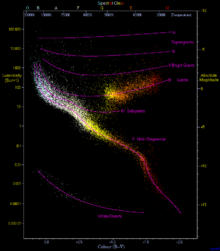HD 114613
| 观测资料 历元 J2000.0 | |
|---|---|
| 星座 | 半人马座[1][2] |
| 星官 | |
| 赤经 | 13h 12m 3.2s[1][2][3] |
| 赤纬 | -37° 48′ 11″[1][2][3] |
| 视星等(V) | 4.852 ± 0.011[1][2][4] |
| 特性 | |
| 光谱分类 | G3IV[5][note 1] |
| U−B 色指数 | 0.31[1][2] |
| B−V 色指数 | 0.659 ± 0.020[4] |
| R−I 色指数 | 0.36[1][2] |
| 天体测定 | |
| 径向速度 (Rv) | -15.0 ± 0.9 km/s |
| 自行 (μ) | 赤经:-381.72 ± 0.31[3] mas/yr 赤纬:45.75 ± 0.20[3] mas/yr |
| 视差 (π) | 48.38 ± 0.29[3] mas |
| 距离 | 67.4 ± 0.4 ly (20.7 ± 0.1 pc) |
| 绝对星等 (MV) | 3.276 ± 0.024[6] |
| 详细资料 | |
| 质量 | 1.25 ± 0.03[7] M☉ |
| 半径 | 2.01 ± 0.06[7] R☉ |
| 表面重力 (log g) | 3.97 ± 0.02[8] |
| 亮度 | 4.057 ± 0.014[8] L☉ |
| 温度 | 5729 ± 17[8] K |
| 金属量 [Fe/H] | 0.19 ± 0.01[8] dex |
| 自转 | 34.1 ± 3.5 days[9] |
| 自转速度 (v sin i) | 2.4 ± 0.5[10] km/s |
| 年龄 | 5.20 ± 0.24[7] Gyr |
| 其他命名 | |
| 参考数据库 | |
| SIMBAD | 资料 |
HD 114613,又名CD-37 8437,SAO 204227、HR 4979,是一颗在半人马座的次巨星,视星等为4.85,位于银经307.43,银纬24.89。距离地球约67光年,目前已确认有一颗长周期太阳系外行星存在,并可能还有未发现行星。
恒星状况
[编辑]
HD 114613位于半人马座ι东南方,距离约8角分处,朝向半人马座中央。虽然该恒星在夜空中可被肉眼观测,但因为半人马座内肉眼可见恒星很多,拜耳天体和佛兰斯蒂德天体目录并未将它收录。
HD 114613的B-V色指数和光谱温度显示它的光谱类型应是G3,这代表它的表面温度只比太阳低50 K,并且外观呈黄色。在赫罗图上HD 114613的位置明显高于主序带,反而接近次巨星分支,这代表它核心中的氢已完全耗尽,并且在赫罗图上移动到巨星分支过程中会增加光度和半径,但表面温度降低。因为它在演化过程中温度降低,代表它在主序星时期的光谱类型属于较早期类型,可能是接近属于 F9V 的时钟座ι。
因为HD 114613即将结束氢融合,它的年龄必定相当古老。根据光谱观测资料得知其质量1.25 ± 0.03 M☉和表面重力log 3.95 ± 0.03 g,可推测出它的年龄为52.0 ± 2.4亿年[7],代表它比太阳稍老。因为恒星的金属量原则上随恒星年龄增加而下降,并且在星系薄盘内恒星年龄和金属量范围极大,所以 HD 114613 的铁含量高达0.19 ± 0.01 dex(太阳的155 ± 4%)是正常的。而巨大行星在 Fe/H = 0.2 dex 的恒星旁形成的几率是15%[11],所以在HD 114613旁发现距行星并不会让人感到意外。
HD 114613的特殊之处在于它的光谱型比太阳更加早期,并且现在是次巨星。而它也有一个磁场改变的周期[9]。它的磁场改变周期为897 ± 61日,比太阳周期短4.5倍,是已知最短的其中一个恒星磁场改变周期。
行星系
[编辑]因为HD 114613较明亮,并且与太阳类似,天文学家将它列为以径向速度法搜寻系外行星的目标。
HD 114613是在南半球自1992年到1998年间进行的 ESO-CES 巡天中首批以径向速度法进行侦测系外行星的37颗恒星其中一颗[12]。该次巡天并未在距离恒星数天文单位内的距离找到任何木星数倍质量的行星。之后天文学家使用高精度径向速度行星搜索器(HARPS)对前述恒星进行更进一步观测,结果认为在距离恒星超过约5天文单位的距离没有质量相当于木星的行星存在[13]。
1998年起HD 114613就是 ESO-CORALIE[11]和 AAT-UCLES[14]这两个行星巡天的对象。因为 CORALIE 在HD 114613找到稳定的径向速度变化,因此天文学家将该恒星列为以更高精度观测的目标,并于2004年使用 HARPS 进行观测[8],之后2005年时它也成为英澳望远镜的观测对象[15][16]。另外,虽然HD 114613并非 Keck-HIRES Eta-Earth 低质量行星巡天计划的主要目标,但自2004年起也纳入该计划观测对象[17]。
行星系统
[编辑]Robert Wittenmyer 等人于2012年发表论文指出[18],HD 114613周围应有一低质量系外行星存在。虽然他们引用了 Mikko Tuomi 等人于2012年提交至《天文与天体物理学报》,但直到2013年才正式出版的论文[19]。该论文提及天仓五和HD 114613的活动分布指数类似。并且截至2014年1月仍无论文宣称在HD 114613周围发现“低质量行星”。
不过,前述研究结果并不表示HD 114613周围并无任何行星。Wittenmyer 等人于2014年宣称发现HD 114613存在周期10.5年的径向速度变化,代表它有一个长周期天体环绕[20]。而径向速度变化的半振幅为5.5 m/s,代表该行星的质量下限为木星的一半。行星的轨道离心率0.25,代表在宽松定义上它是类木星行星。波江座40b _ HD20794c _HD85512b_HD 114613b 伪阳性讯号
| 成员 (依恒星距离) |
质量 | 半长轴 (AU) |
轨道周期 (天) |
离心率 | 倾角 | 半径 |
|---|---|---|---|---|---|---|
| b | ≥0.48 ± 0.04 MJ | 5.16 ± 0.13 | 3827 ± 105 | 0.25 ± 0.08 | — | — |
注释
[编辑]- ^ SIMBAD 的资料是G3V。该恒星光度明显高于典型主序星应有的光度。在赫罗图上它的位置应是在次巨星。
参考资料
[编辑]- ^ 1.0 1.1 1.2 1.3 1.4 1.5 Pulsating variable Star. SIMBAD. Centre de Données astronomiques de Strasbourg. [2012-07-13].
- ^ 2.0 2.1 2.2 2.3 2.4 2.5 VizieR Detailed Page. [2012-07-13]. (原始内容存档于2016-03-05).
- ^ 3.0 3.1 3.2 3.3 3.4 van Leeuwen, F. Validation of the new Hipparcos reduction. Astronomy and Astrophysics. 2007, 474 (2): 653–664 [2014-02-12]. Bibcode:2007A&A...474..653V. arXiv:0708.1752
 . doi:10.1051/0004-6361:20078357. (原始内容存档于2016-04-02).
. doi:10.1051/0004-6361:20078357. (原始内容存档于2016-04-02).
- ^ 4.0 4.1 Høg, E.; et al. The Tycho-2 catalogue of the 2.5 million brightest stars. Astronomy and Astrophysics. 2000, 355: 27–30. Bibcode:2000A&A...355L..27H.
- ^ A Modern Mean Stellar Color and Effective Temperatures (Teff) # Sequence for O9V-Y0V Dwarf Stars (页面存档备份,存于互联网档案馆), E. Mamajek, 2011, website
- ^ 绝对星等的计算式:。 是绝对星等, 是视星等。
- ^ 7.0 7.1 7.2 7.3 Takeda, Genya; et al. Structure and Evolution of Nearby Stars with Planets. II. Physical Properties of ~1000 Cool Stars from the SPOCS Catalog. The Astrophysical Journal Supplement Series. 2007, 168 (2): 297–318. Bibcode:2007ApJS..168..297T. arXiv:astro-ph/0607235
 . doi:10.1086/509763.
. doi:10.1086/509763.
- ^ 8.0 8.1 8.2 8.3 8.4 Sousa, S. G.; et al. Spectroscopic parameters for 451 stars in the HARPS GTO planet search program. Stellar [Fe/H] and the frequency of exo-Neptunes. Astronomy and Astrophysics. August 2008, 487 (1): 373–381. Bibcode:2008A&A...487..373S. arXiv:0805.4826
 . doi:10.1051/0004-6361:200809698.
. doi:10.1051/0004-6361:200809698.
- ^ 9.0 9.1 Lovis, C.; et al. The HARPS search for southern extra-solar planets. XXXI. Magnetic activity cycles in solar-type stars: statistics and impact on precise radial velocities. Astronomy and Astrophysics (submitted). 2011. arXiv:1107.5325
 .
.
- ^ Valenti, J. A.; Fischer, D. A. Spectroscopic Properties of Cool Stars (SPOCS). I. 1040 F, G, and K Dwarfs from Keck, Lick, and AAT Planet Search Programs. The Astrophysical Journal Supplement Series. 2005, 159 (1): 141–166. Bibcode:2005ApJS..159..141V. doi:10.1086/430500.
- ^ 11.0 11.1 Mortier, A.; et al. On the functional form of the metallicity-giant planet correlation. Astronomy & Astrophysics. 2013, 551. Bibcode:2013A&A...551A.112M. arXiv:1302.1851
 . doi:10.1051/0004-6361/201220707.
. doi:10.1051/0004-6361/201220707.
- ^ Endl, M.; et al. The planet search program at the ESO Coudé Echelle spectrometer. III. The complete Long Camera survey results. Astronomy & Astrophysics. 2002, 392: 671–690. Bibcode:2002A&A...392..671E. arXiv:astro-ph/0207512
 . doi:10.1051/0004-6361:20020937.
. doi:10.1051/0004-6361:20020937.
- ^ Zechmeister, M.; et al. The planet search programme at the ESO CES and HARPS. IV. The search for Jupiter analogues around solar-like stars. Astronomy & Astrophysics. 2013, 592. Bibcode:2013A&A...552A..78Z. arXiv:1211.7263
 . doi:10.1051/0004-6361/201116551.
. doi:10.1051/0004-6361/201116551.
- ^ Jones, Hugh R. A.; et al. Extrasolar planets around HD 196050, HD 216437 and HD 160691. Monthly Notices of the Royal Astronomical Society. 2002, 337 (4): 1170–1178. Bibcode:2002MNRAS.337.1170J. arXiv:astro-ph/0206216
 . doi:10.1046/j.1365-8711.2002.05787.x.
. doi:10.1046/j.1365-8711.2002.05787.x.
- ^ Wittenmyer, Robert A.; et al. The Frequency of Low-mass Exoplanets. II. The "Period Valley". The Astrophysical Journal. 2010, 722 (2). Bibcode:2010ApJ...722.1854W. arXiv:1008.5232
 . doi:10.1088/0004-637X/722/2/1854.
. doi:10.1088/0004-637X/722/2/1854.
- ^ Wittenmyer, Robert A.; et al. The Frequency of Low-mass Exoplanets. III. Toward η⊕ at Short Periods. The Astrophysical Journal. 2011, 738 (1). Bibcode:2011ApJ...738...81W. arXiv:1103.4186
 . doi:10.1088/0004-637X/738/1/81.
. doi:10.1088/0004-637X/738/1/81.
- ^ Howard, Andrew A.; et al. The Occurrence and Mass Distribution of Close-in Super-Earths, Neptunes, and Jupiters. Science. 2010, 330. Bibcode:2010Sci...330..653H. arXiv:1011.0143
 . doi:10.1126/science.1194854.
. doi:10.1126/science.1194854.
- ^ Wittenmyer, Robert A.; et al. The Anglo-Australian Planet Search. XXII. Two New Multi-planet Systems. The Astrophysical Journal. 2012, 753 (2). 169. Bibcode:2012ApJ...753..169W. arXiv:1205.2765
 . doi:10.1088/0004-637X/753/2/169.
. doi:10.1088/0004-637X/753/2/169.
- ^ Tuomi, M.; et al. Signals embedded in the radial velocity noise. Periodic variations in the τ Ceti velocities. Astronomy & Astrophysics. 2013, 551. Bibcode:2013A&A...551A..79T. arXiv:1212.4277
 . doi:10.1051/0004-6361/201220509.
. doi:10.1051/0004-6361/201220509.
- ^ 20.0 20.1 Wittenmyer, Robert A.; et al. The Anglo-Australian Planet Search. XXIII. Two New Jupiter Analogs. The Astrophysical Journal. 2014. arXiv:1401.5525
 .
.




